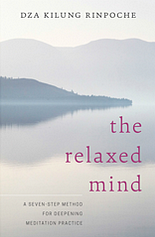
Dza Kilung Rinpoche was a guest teacher recently at East West Bookshop. He is a lama of the Nyingma School of Tibetan Buddhism, the fifth reincarnation in a line of enlightened yogis. Rinpoche first came out of Asia to Seattle in 1998, and now leads an international sangha, with his main residence on Whidbey Island. At the same time that he oversees multiple projects, including the building of a new temple on the island, he has maintained responsibilities as the head of his monastery in eastern Tibet, and makes trips there annually. This Journal entry was written by Diane Berger, who initially brought Rinpoche to Seattle, and helped him develop the Kilung Foundation and Pema Kilaya Sangha. Diane currently teaches meditation and Buddhism in Seattle.
The room was filled with warmth and an inner brightness, even before Dza Kilung Rinpoche stepped through the doors. This Tibetan lama was already known to many in the full house at East West on Sunday, December 2, as he has been teaching in Seattle for the last twenty years. Once he took his seat, the audience was rapt and devoted. The topic was a continuation of his previous engagement months before—the seven meditations of his book, The Relaxed Mind: A Seven-Step Method For Deepening Meditation Practice. This Sunday, he deftly took us on a journey through all seven meditations, explaining, and then leading us deeply in each.
To meditate in the presence of a reincarnated meditation master is a kind of transmission, a teaching accessed beyond language, through experience. And so he, and I think most of us, approached this day as a kind of meditation retreat—for us, an opportunity to sit in meditation with a master, regardless of the cognitive material presented. But in fact his words were lucid, fresh, and instructive. Here is a sampling.
Meditation 1: Make a habit of awareness of one’s body, of resting with the body, as the starting point of every meditation session. He advised those with chronic tension or pain to keep awareness of the entire body and being, rather than staying pinpointed at the source of the trouble.
Meditation 2: In Calm Abiding, we extend this body awareness to the breath, or resting the gaze on an object in our visual field. At this point we’re training for focus and calm, but importantly, in an unpressured way. The “single” of single-pointedness often referred to in this meditation doesn’t mean to focus on an isolated object; rather it’s a unified perspective that we want to foster. Then, one’s focus becomes subtle and relaxed.
Meditation 3: For Refined Sitting meditation, one drops the breath as the object of meditation. One pulls back, without grasping onto an object, experiencing a bigger space…a joy with satisfaction, contentment, almost an “as it is” state of mind. This gives rise to clarity, not as a sudden light bulb switching on, but as a growing lack of confusion. This growing energy can become a radiation of the heart, of bodhicitta: compassion. Then that becomes the focus.
Meditation 4: Let it be. Insight meditation as taught by the Tibetan lamas is often a much more global and relaxed approach than what one may encounter in other traditions. Clarity is the main point here, along with awareness of the present moment, and is a natural outgrowth of practice one has developed in the preceding meditations. Rinpoche’s main point today was to allow, to notice the resting mind, to let it be. It can be that simple.
Meditation 5: Rinpoche summed up Open Heart-Mind meditation with this story. Sometimes people come to him for pith instructions—a simple, direct way to work with their mind and progress on the path of Buddhism. He tells them, “Open your heart, your mind. Just sit with that and see how it goes…This can bring one to a vast view. Everything is there.” That’s the essence of this meditation, and it can be a powerful tool. He said he finds that in highly developed countries like ours people are so busy, so tied up, without time for the inner self. So the heart-mind needs this opportunity to open—to contact our humanity. And then we can extend this openness, without walls of any kind, to all sentient beings, even to ourselves.
Meditation 6: Attitude is all. This sums up Pure Mind meditation: to protect against the neurotic tendencies of one’s mind, to give up stories about things that have happened, and then to develop a more positive perspective and qualities. This is also sometimes called Sacred Outlook, and can be applied to how we can view the environment, the earth as sacred. And beyond, to seeing the true nature of things, that purity is just there. Some examples to nurture: Let me see the courageous side of myself, rather than a closed-off version of myself. Or, if during meditation the phone rings, or someone snores, think: Ah! there’s a ring that’s pure, snoring that’s pure.
Meditation 7: Non-Conceptual meditation is an entry into Dzogchen, which is about letting go, free of any engagement. This is not about thoughtlessness, as potentially more thoughts can appear. But truly no walls, totally free with a vast view. Non-doing and utter simplicity. At this point, we don’t try to change the thoughts, and our knowing mind remains aware. But there’s no separation between experience and the experiencer. The final instruction? Give freedom to your inner mind.
Rinpoche’s book, The Relaxed Mind: A Seven-Step Method For Deepening Meditation Practice, is available at East West Bookshop.

